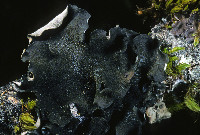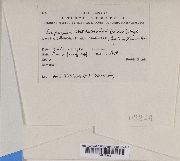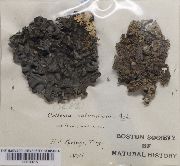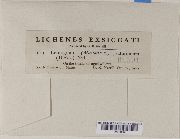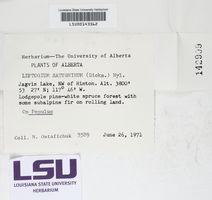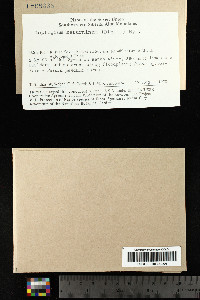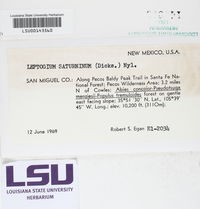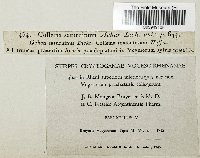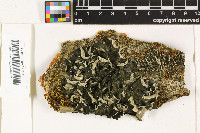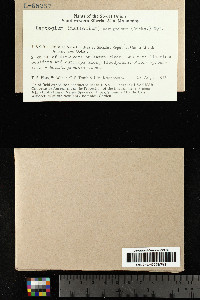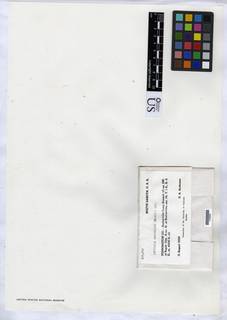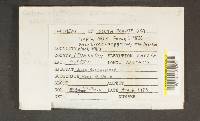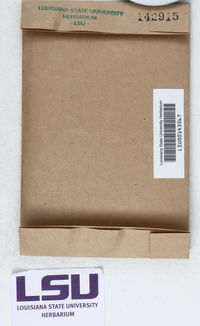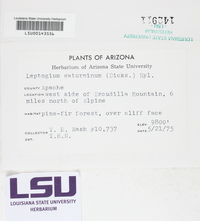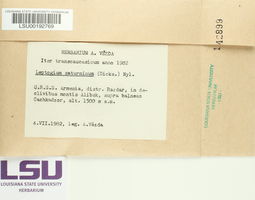
Consortium of Lichen Herbaria
- building a Global Consortium of Bryophytes and Lichens as keystones of cryptobiotic communities -
- Home
- Search
- Images
- Species Checklists
- US States: O-Z >
- US National Parks
- Central America
- South America
- US National Parks
- Southern Subpolar Region
|
|
|
|
Family: Collemataceae
[Collema saturninum (Dicks.) DC. & Lam., moreCollema saturninum var. australe (Hook. f. & Taylor) Hook. f. & Taylor, Collema saturninum var. saturninum (Dicks.) DC. & Lam., Lichen saturninus Dicks., Mallotium saturninum (Dicks.) Gray, Parmelia myochroa var. saturnina (Dicks.) Schaer., Parmelia saturnina (Dicks.) Ach.] |
Nash, T.H., Ryan, B.D., Gries, C., Bungartz, F., (eds.) 2004. Lichen Flora of the Greater Sonoran Desert Region. Vol 2. Thallus: foliose, 2-8(-10) cm in diam., adnate, subdichotomously to irregularly lobate lobes: irregular, elongate, +plane, separate, 3-10 mm wide, 100-200(-300) µm thick; apices rotund, entire to irregularly cut and isidiate, occasionally upturned upper surface: dark olivaceous gray to almost black, usually dull, usually smooth isidia: scattered to dense, usually laminal but sometimes marginal, usually granular, black, rarely elongate and becoming branched, usually simple, usually darker than the thallus internal anatomy: with upper and lower cortices consisting of a single (rarely double) layer of irregularly isodiametrical cells 3-9 µm in diam., internally with loosely interwoven chains of Nostoc and hyphae lower surface: pale to medium brown, wrinkled, with dense white tomentum of cylindrical hairs up to 0.2 mm long Apothecia: rare, laminal, sessile, 0.5-2.5 mm wide disc: brown to red-brown, plane to convex margin: thalline, concolorous with the thallus, entire or sometimes granulose exciple: euparaplectenchymatous, 20-25 µm centrally hymenium: hyaline below and thinly brown above, 100-125 µm tall; paraphyses: unbranched, 1-2 µm wide, slightly inflated apically; subhymenium: pale yellow, 20-25 µm thick asci: cylindrico-clavate, 8-spored ascospores: hyaline, muriform, 3-4-septate transversely, 1-septate longitudinally, ellipsoid to subfusiform, 20-25 x 7-10 µm Pycnidia: not observed Spot tests: all negative Secondary metabolites: none detected. Substrate and ecology: frequent on bark of conifers and occasionally on acidic rocks among mosses, at moderately high elevations World distribution: widely distributed in North America, particularly in northern areas, and in Europe and Asia Sonoran distribution: Arizona, southern California, Baja California and Chihuahua. Notes: Large, very dark gray, isidate Leptogiums with well developed white tomentum underneath can be identified as either L. burnetiae or L. saturninum. The former species has large aggregates of coralloid isidia that sometimes become elevated on a stalk; whereas, the latter species has granular isidia that are often widely scattered across its thallus. |
|
|
|
Powered by Symbiota



